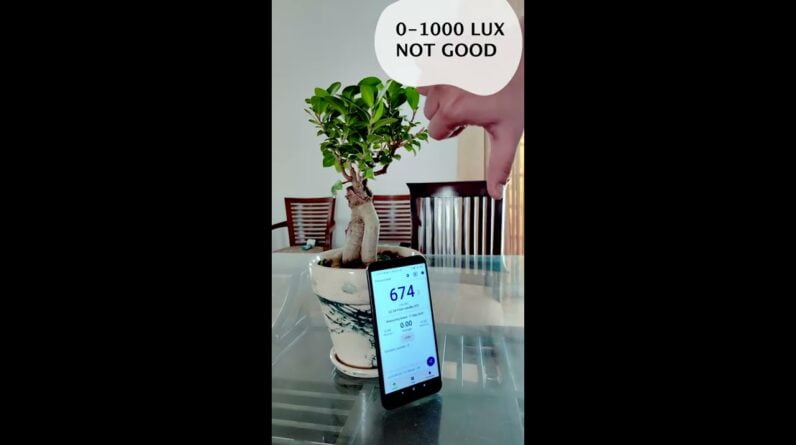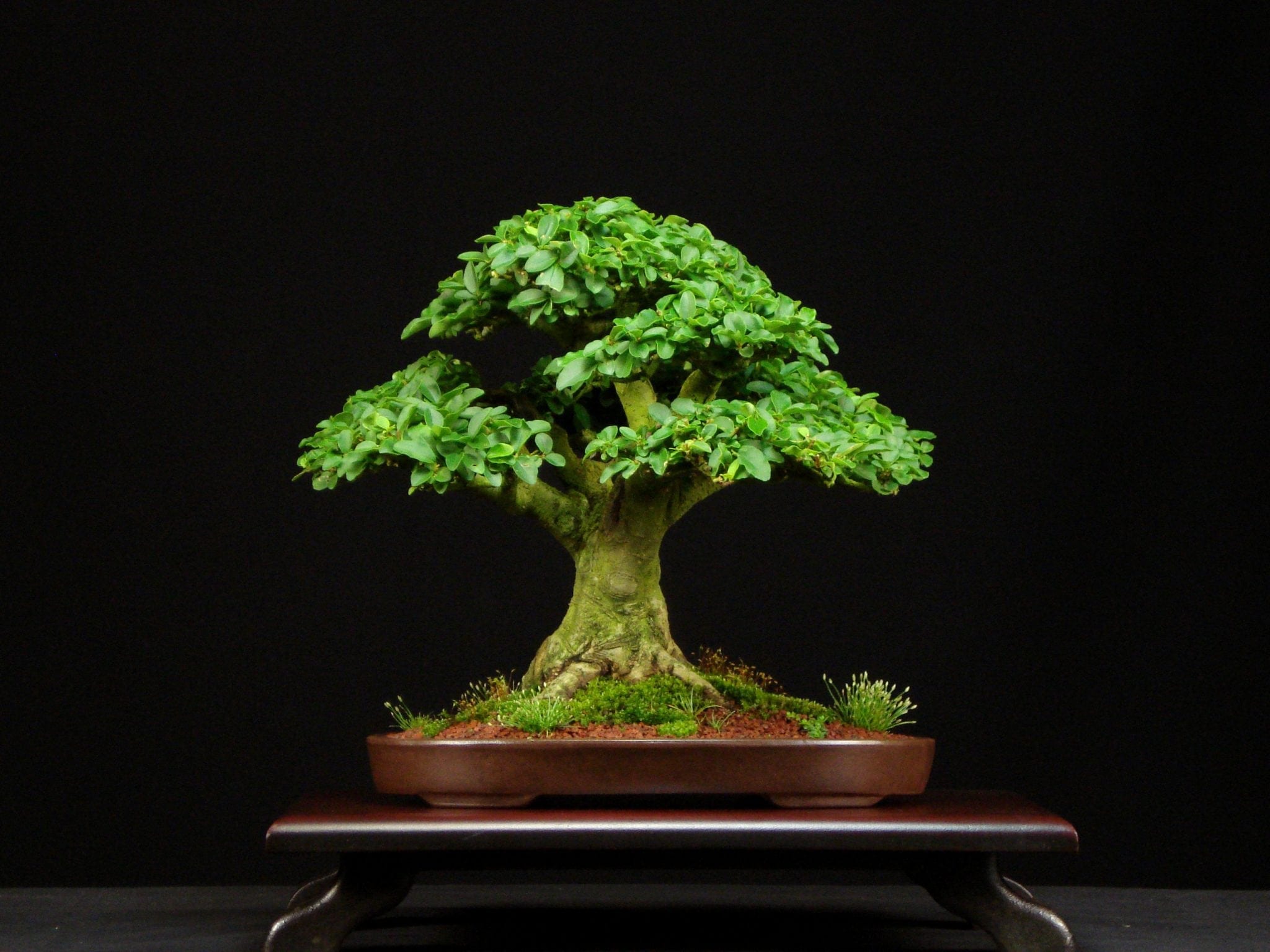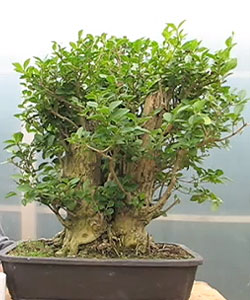
Looking to create a stunning indoor bonsai? Look no further than the Privet Tree! With its beautiful flowering, glossy leaves, and old, mature appearance, the Privet Tree is the perfect addition to any indoor space.
Whether you’re a beginner or a seasoned bonsai enthusiast, the Privet Tree offers endless possibilities for creativity and customization. In this article, we’ll explore the different varieties of Privet Trees, discuss optimal growing conditions, and provide expert tips on training and shaping your very own Privet Bonsai Tree.
So get ready to bring a touch of nature and artistry into your home with the captivating beauty of the Privet Tree.
Choosing the Right Privet Tree
When it comes to choosing the right privet tree for your bonsai, there are a few factors to consider.
Consider the Size
First and foremost, consider the size of the tree. Privet trees come in different sizes, so it’s important to choose one that fits your space and aesthetic preferences. If you’re looking for a larger bonsai, opt for a ligustrum lucidum or a ligustrum japonicum. These species can grow up to 30 feet tall, making them ideal for creating a dramatic bonsai display. On the other hand, if you prefer a smaller bonsai, ligustrum ovalifolium or ligustrum vulgare may be more suitable. These species typically grow to a height of 6 to 8 feet.
Select a Healthy Tree
When selecting a privet tree for bonsai, it’s crucial to choose a healthy specimen. Look for a tree with vibrant and glossy leaves, as this indicates good overall health. Avoid trees with yellowing or dull leaves, as these could be a sign of disease or stress. Additionally, check for any signs of pests, such as webs or holes in the leaves. A healthy tree will have strong and well-formed branches, which will make it easier to shape and maintain as a bonsai.
Choose a Species
There are several species of privet trees that can be used for bonsai. Some common species include ligustrum lucidum, ligustrum japonicum, ligustrum ovalifolium, and ligustrum vulgare. Each species has its own unique characteristics, so consider your preferences and the specific requirements of each species before making a decision. For instance, ligustrum lucidum is known for its glossy leaves and white flowers, while ligustrum japonicum has small, dark green leaves and produces clusters of white flowers in the spring.
Preparing the Tree for Bonsai
Before you can begin shaping your privet tree into a bonsai, it’s important to prepare the tree for this art form.

Trimming and Pruning
Start by trimming and pruning the tree to remove any unwanted branches or foliage. This process helps to create a clean and well-balanced structure for the bonsai. Use sharp bonsai shears to carefully trim away any branches or shoots that are crossing each other or growing in an undesirable direction. Additionally, remove any branches or foliage that are weak or damaged. This will help to promote healthy growth and improve the overall appearance of the bonsai.
Wiring the Branches
Wiring the branches is another essential step in preparing the tree for bonsai. This technique involves wrapping wire around the branches to guide their growth and create the desired shape. The wire should be applied in a careful and precise manner, taking care not to damage the branches or restrict their natural movement. Use aluminum or copper wire, as these materials are flexible and easy to work with. Be sure to wrap the wire in a spiral motion, starting from the base of the branch and working your way to the tip.
Repotting the Tree
Finally, consider repotting your privet tree to ensure its health and vitality as a bonsai. Repotting involves transferring the tree to a new container or pot with fresh soil. This process helps to refresh the tree’s root system and provide it with the necessary nutrients. When repotting, be gentle with the roots to avoid damaging them. Use a well-draining bonsai soil mix to provide optimal conditions for the tree’s growth. Repotting is typically done every 2-3 years, depending on the tree’s growth rate and root development.
Creating the Bonsai Shape
Now that your privet tree is prepared for bonsai, it’s time to start shaping it into a visually stunning masterpiece.

Decide on the Bonsai Style
First, determine the bonsai style that you want to create with your privet tree. There are several traditional styles to choose from, including formal upright, informal upright, slanting, cascade, and windswept. Consider the natural growth pattern and characteristics of your privet tree when deciding on the style.
For instance, if the tree has a strong and straight trunk, the formal upright style may be a good choice. On the other hand, if the tree has a curved trunk, the informal upright style may be more suitable.
Prune for Shape
Pruning is key to shaping the bonsai and creating the desired form. Start by removing any branches or shoots that are not in line with the chosen style. Use sharp bonsai shears to make clean cuts, taking care not to damage the surrounding branches or foliage. Prune judiciously to maintain the overall health and vigor of the tree. Remember to step back and evaluate the shape as you go, making adjustments as needed to achieve the desired aesthetic.
Wiring for Shape
In addition to pruning, wiring can be used to further shape the branches of the bonsai. This technique allows for greater control over the tree’s form and can help create more intricate and dynamic designs. When wiring, take care to wrap the wire around the branches without causing any harm or constriction. The wire should be tight enough to hold the shape but loose enough to allow for continued growth. Leave the wire in place for several months to allow the branches to set in the desired position before removing it.
Providing the Right Environment
To ensure the health and vitality of your privet bonsai, it’s important to provide it with the right environment.

Temperature and Humidity
Privet trees thrive in moderate temperatures and humidity levels. They prefer temperatures between 60-75°F (15-24°C) and humidity levels of around 50-70%. Avoid exposing the bonsai to extreme temperature fluctuations or drafts, as this can stress the tree and impact its overall health. If you live in an area with hot summers or cold winters, consider bringing the bonsai indoors or providing some form of protection, such as a shade cloth or a greenhouse.
Light Requirements
Privet trees require direct sunlight to thrive. Place your bonsai in a location where it can receive at least 4-6 hours of sunlight each day. If you’re growing your bonsai indoors, consider placing it near a south-facing window or using artificial grow lights to supplement natural light. Be mindful of the intensity of the sunlight, as excessive exposure can cause leaf burn. If necessary, provide some shade during the hottest part of the day to protect the tree.
Choosing the Right Pot
The choice of pot is not only important for aesthetic reasons but also for the health and development of the bonsai. Select a pot that is the right size for your privet bonsai, allowing enough space for the roots to grow and develop. The pot should have drainage holes to prevent waterlogging and promote good airflow to the roots. Additionally, consider the material of the pot. Ceramic pots are a popular choice for bonsai, as they provide stability, insulation, and a visually appealing aesthetic. Choose a pot that complements the style and size of your bonsai.
Watering and Fertilizing
Proper watering and fertilizing are essential for the growth and vitality of your privet bonsai.

Watering Frequency
Water your bonsai when the top layer of soil feels dry to the touch. Avoid overwatering, as this can lead to root rot and other issues. Use a watering can or a gentle spray nozzle to water the bonsai evenly, ensuring that the water reaches all parts of the soil. The frequency of watering will depend on various factors such as temperature, humidity, and pot size. Check the moisture level of the soil regularly and adjust your watering schedule accordingly.
Choosing the Right Fertilizer
To provide your privet bonsai with the necessary nutrients, choose a balanced bonsai fertilizer. Look for a fertilizer with equal amounts of nitrogen, phosphorus, and potassium. This will promote overall growth, root development, and flowering. Use a slow-release fertilizer to ensure a steady supply of nutrients over a long period. Additionally, consider using organic fertilizers, such as fish emulsion or compost, to provide a natural and gentle source of nutrients for your bonsai.
Fertilizing Schedule
Establish a consistent fertilizing schedule for your privet bonsai. In general, bonsai should be fertilized every 4-6 weeks during the growing season, which typically starts in spring and ends in fall. During the winter months, when the tree is in a dormant state, reduce or stop fertilizing altogether. Follow the instructions on the fertilizer packaging for the recommended dosage and application method. Be mindful not to over-fertilize, as this can lead to nutrient burn and other problems.
Dealing with Pests and Diseases
Despite our best efforts, pests and diseases can still affect our bonsai. It’s important to be vigilant and take appropriate measures to prevent and treat these issues.
Common Pests
Some common pests that can affect privet bonsai include aphids, scale insects, and spider mites. These pests can cause damage to the leaves, stems, and overall health of the tree. Inspect your bonsai regularly for any signs of pest infestation, such as discolored leaves, sticky residue, or webbing. If you notice any pests, take immediate action to control and eliminate them.
Preventive Measures
To prevent pest infestations, maintain good hygiene practices for your bonsai. Keep the tree clean and free from dead leaves and debris. Regularly inspect the tree for any signs of pests and take action promptly if necessary. Additionally, consider using natural pest deterrents, such as neem oil or insecticidal soap. These products are safe for use on bonsai and can help to deter and control pests without harming the tree.
Treating Diseases
If your privet bonsai succumbs to a disease, it’s important to take swift action to treat and contain the issue. Some common diseases that can affect bonsai include fungal infections, root rot, and leaf spot. These diseases can cause discoloration, wilting, and decay of the foliage and can spread quickly if not addressed promptly. Consult a plant expert or bonsai professional for guidance on the appropriate treatment methods for your specific disease.
Training and Maintaining the Bonsai
Training and maintaining your privet bonsai is an ongoing process that requires regular care and attention.
Regular Trimming and Pruning
Regular trimming and pruning are essential to maintain the shape and structure of your bonsai. Remove any unwanted branches, shoots, or foliage to keep the bonsai well-balanced and aesthetically pleasing. Prune with purpose and intention, always considering the overall health and growth of the tree. Regular trimming and pruning will also help to stimulate new growth and maintain the bonsai’s size and proportions.
Wiring and Shaping
Wiring and shaping are important techniques in maintaining the bonsai’s form and style. Check the wiring periodically to ensure that it is not causing any damage or constriction to the branches. If necessary, adjust or remove the wire to avoid any harm to the tree. Assess the shape and structure of your bonsai regularly and make necessary adjustments to maintain the desired aesthetic. Be patient and allow the bonsai to grow and develop over time, adjusting the wiring and shaping as needed.
Repositioning the Tree
Periodically reposition your privet bonsai to promote even growth and prevent bending or tilting of the trunk. Rotate the bonsai at regular intervals, ensuring that all sides of the tree receive adequate sunlight. Repositioning the tree also helps to prevent any one side from becoming dominant and promotes a more balanced and harmonious growth pattern. Be careful when handling the bonsai to avoid causing damage to the roots or branches.
Seasonal Care for Indoor Bonsai
Indoor bonsai, including privet trees, require specific care during different seasons to ensure their health and well-being.
Winter Care
During the winter months, privet bonsai should be protected from extreme cold temperatures. If possible, bring the bonsai indoors to a cool, well-lit location, such as a south-facing window. The indoor environment will provide the necessary protection from frost and cold winds. Reduce the frequency of watering during this time, as the tree’s growth slows down. Monitor the soil moisture and only water when the top layer feels slightly dry.
Spring Care
In spring, as the weather warms up, your privet bonsai will enter its active growth phase. Increase the frequency of watering to accommodate the tree’s increased water requirements. Monitor the soil moisture closely and adjust the watering schedule as needed. This is also a good time to apply a balanced fertilizer to promote healthy growth and flowering. Prune any dead or damaged branches and conduct a thorough inspection for pests or diseases.
Summer Care
Summer care for privet bonsai involves protecting the tree from excessive heat and maintaining adequate hydration. Provide shade during the hottest part of the day to prevent leaf burn and dehydration. Ensure that the bonsai receives sufficient airflow to prevent stagnant air and humidity, which can lead to fungal diseases. Water the bonsai regularly, keeping the soil evenly moist but not waterlogged. Monitor the tree for any signs of stress or pest infestation and take appropriate action if needed.
Displaying and Showcasing the Bonsai
Displaying your privet bonsai in an attractive and effective manner can enhance its beauty and impact. Consider the following tips for showcasing your bonsai.
Choosing the Right Stand
Select a bonsai stand or display table that complements the style and size of your privet bonsai. The stand should be sturdy and stable, providing a secure base for the bonsai. Consider the material and finish of the stand, ensuring that it enhances the overall aesthetic. Wooden stands are a popular choice for their natural and timeless appeal. Experiment with different stand options to find the one that best showcases your bonsai.
Effective Display Techniques
When displaying your privet bonsai, consider the principles of balance, symmetry, and depth. Use various display techniques to create visual interest and highlight the unique features of the tree. Choose a focal point for your display, such as a beautifully shaped branch or a flowering cluster. Arrange the bonsai and any accent pieces, such as rocks or small figurines, in a visually pleasing manner. Consider the background and lighting of the display area, ensuring that it enhances the overall impact of the bonsai.
Entering Bonsai Shows
Participating in bonsai shows can be a rewarding experience and an opportunity to showcase your privet bonsai to a larger audience. Research local bonsai clubs or organizations that organize shows and exhibitions. Prepare your bonsai meticulously, ensuring that it is in prime condition for display. Take high-quality photographs of your bonsai from different angles to submit along with your application. Follow the guidelines and requirements of the show organizers and be prepared to answer questions and engage with fellow bonsai enthusiasts during the event.
Summing Up
Choosing the right privet tree, preparing it for bonsai, shaping it into a beautiful form, providing the right environment, and maintaining its health and attractiveness are all essential steps in creating a stunning indoor bonsai. With proper care and attention, your privet bonsai can become a captivating centerpiece in your home or garden.
Enjoy the process of nurturing and shaping your bonsai, and take pride in the unique and timeless art form that is bonsai.
Do You Need Special Soil for Bonsai
The Best-Kept Secrets of Ficus Bonsai Success: Tips and Tricks Revealed


